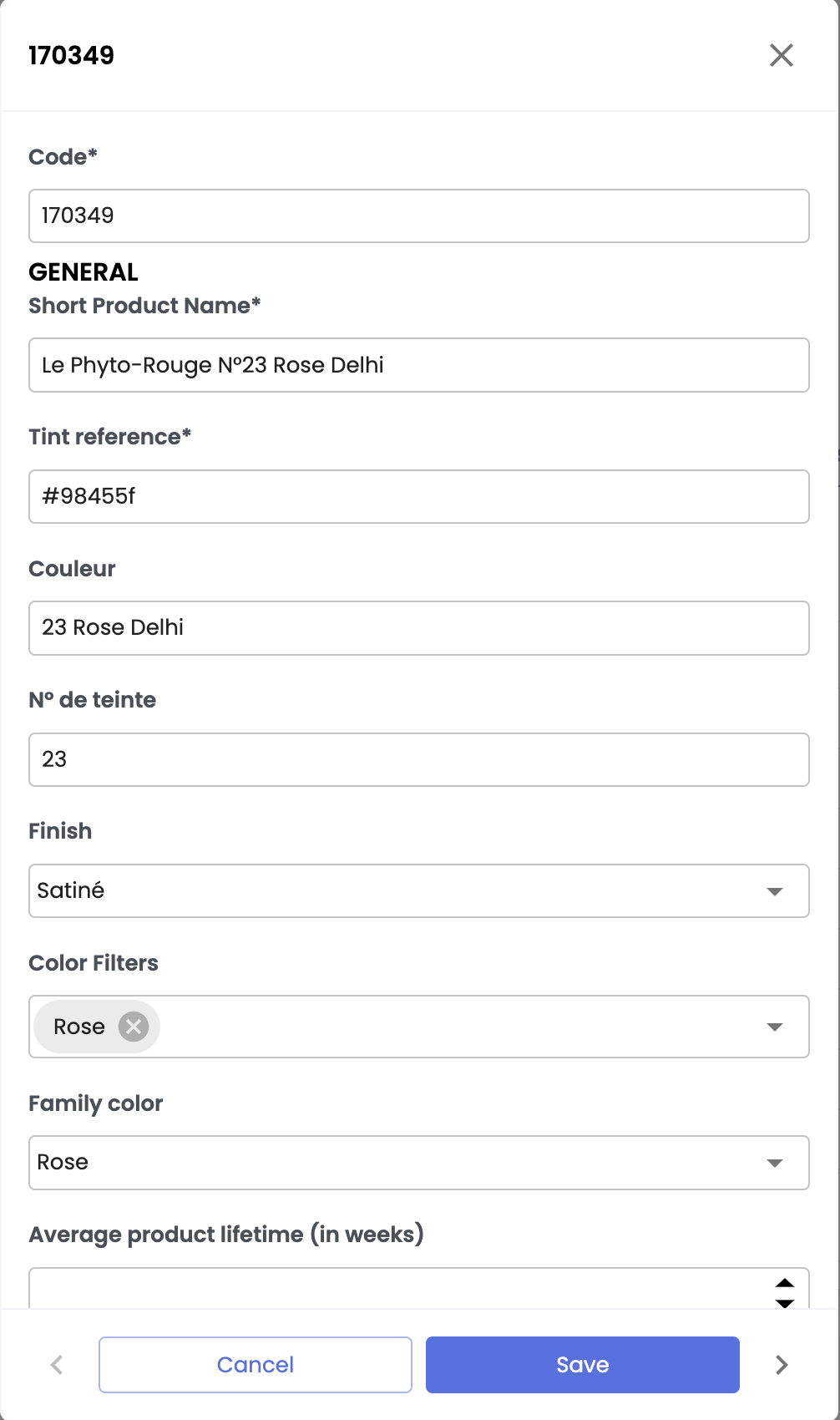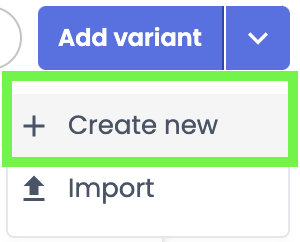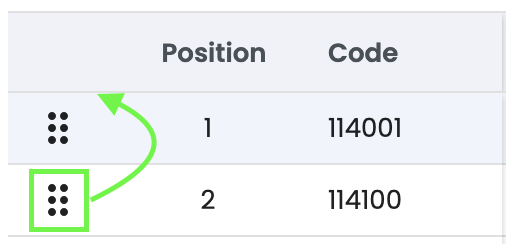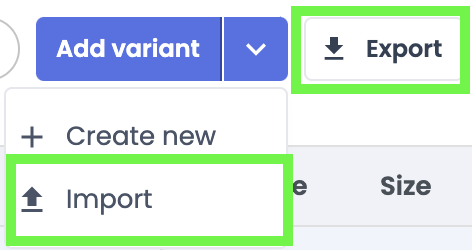Enriching Variant Data
Learning objectives
- Access variants on a product sheet
- Manage the enrichment of variant attributes and assets
- Know best practices to optimize your variant management processes
1. Presentation of the variants tab
Accessingvariants
- The activation of variants depends on the PIM administrator. This feature must be activated if it is relevant for your company's needs.
- If you do not see the Variants tab, it means this feature is not active in your environment. Contact your CSM.
Access the variants through the Variants tab available on the product sheet.

What is a variant?
Variants are product sheet derivatives, designed to manage differences such as size, color, or specific versions, without creating a duplicate of the main product sheet. For example, a T-shirt product can have variants for sizes S, M, and L.
Variants allow centralizing common information in a main product sheet, while providing unique specifications for each derivative. This simplifies data management and avoids inconsistencies between multiple product sheets.
Variant characteristics
- Centralized management in the Variants tab: All variants of a product sheet are grouped in this tab. You will find detailed information and specific actions to manage your variants.
- Exclusive association with a product sheet: Each variant belongs to a single product sheet. However, it is possible to dissociate a variant and associate it with another product sheet, as long as both sheets are of the same document type.
- Dependency on attribute sets: The attributes displayed in variants depend on the attribute set configured on the product sheet. If an attribute set excludes certain attributes associated with a variant, these will not be accessible from the variant.
The diagram below details the elements available in the Variants tab:

LimitationsCollaboration tools, completeness indicators, and tags do not take into account the attributes and links specific to variants.
2. Enriching variant attributes
You can enrich variant attributes using two approaches:
- Unitary modification via a dedicated window.
- Bulk modification directly in the table in the Variants tab.
Unitary modification
- Click on the Edit button next to the concerned variant,

- A window opens,
- Fill in the variant attributes' values,

- Click on Save to confirm your changes,
- Use the arrows at the bottom of the window to move to the previous or next variant.
Manual savingAfter enriching the attributes of a variant in the dedicated window, make sure to click Save before moving to the next variant or closing the window.
Bulk modification in the table
This method allows you to enrich a large volume of data and variants quickly. However, it requires pre-configuring the table view.
- Open the contextual menu of a label in the column header by clicking on the three dots "⋮", then select Manage columns,

- Enable the attributes to display in the table using the sliders. The table updates in real time based on your selection,
- Rearrange, if necessary, the width and layout of columns to facilitate table reading,
- Click directly in the table cells to enrich the attributes. Use the Tab key to move to the next cell.
Automatic savingChanges made directly in the table are saved automatically. No additional saving action is needed.
3. Adding assets to links
Now that we know how to enrich variant attributes, let's look at how to associate assets with the specific variant-asset link.
Unlike assets linked to product sheets, there is only one variant-asset link.
- Select the variant from the table for which you want to add an asset,
- The lower part of the page, in the Asset Link section, allows you to add assets to the selected variant.
- You have two options:
- Add and link a new asset via import,
- Or link an existing asset already present in the DAM.
Link a new asset to be imported into the DAM
If the asset is not yet present in the DAM, you can upload a new file and link it to the product sheet at the same time.

- Click on the Add new assets button and select the file you want to link to this variant from your workstation.
- A Download window opens, allowing you to confirm your upload by clicking on the Start button. Multiple assets can be uploaded at the same time.
TipsUploaded assets will be classified in the default classification node of your DAM. If you observe a specific classification for assets in your DAM, you will need to move the uploaded assets to the appropriate classification node. However, the link between the variant and the asset will always remain effective.
The asset is already present in the DAM
If the asset is present in the DAM, you can directly link it to the variant.

- Enter the name or code of the asset in the input field, then select it from the drop-down menu.
TipsIt might be helpful, to facilitate asset identification, to open a new tab in your web browser and load the DAM classification page. This way, you can quickly access the name or code of the asset you want to associate with the variant.
4. Other actions on variants
Create a new variant
To add a new variation to a product sheet, follow these steps. For example, if your product T-shirt already has sizes S, M, and L, and you want to add sizes XS and XL:
- Click the Add variant and "Create new" button to create a new variant.

- A window will open,
- Enter the specific information for the new size, then click Add,
- The new variant will automatically be added to the existing list in the variant table.
- Repeat the process for the next size.
Rearranging variants
To change the order of variants in the table, for example, to rearrange the sizes of variants XS, S, M, L, and XL:
- Click and hold the ⋮⋮ icon at the beginning of the line in the variant table,
- Rearrange the variants by simple drag-and-drop to the desired order.

Unlink a variant
If a variant is not correctly associated with a product sheet, you can unlink it:
- Click the Unlink button at the end of the line of the concerned variant,

- This action breaks the link between the variant and the product sheet,
- You can then re-link this variant to another product sheet via the orphan page.
Import and export variants
To create or update multiple variants in bulk, in a single operation, without manual actions, use the Import and Export features.

- Click the Export button to retrieve the Excel file in .xlsx format,
- Open the file in a spreadsheet and enter the data directly. Create new rows to add new variants. Save the .xlsx file,
- Use the Import button to import the .xlsx file again and add variants in bulk.
Excel file formatMake sure to follow the format and structure of the Excel file to ensure the successful import and correct creation of new variants with the associated data.
SummaryVariant Overview:
- Variants allow you to manage the variations (size, color, version, etc.) of a product sheet.
- Each variant is linked to a single product sheet.
- Their activation depends on the PIM administrator.
Attribute data management:
- Enrichment of variants is possible either individually via a dedicated window or in bulk via the table.
- You can add or link specific asset to variants, whether the files are already in the DAM or need to be imported.
- Creation of new variants via a dedicated window, or in bulk through an import file.
- Rearranging variants by drag-and-drop to adjust their order.
- Unlinking variants for reassignment to another product sheet via the orphan page.
Next Chapter
Now that you know how to enrich variant data, let's see how to Perform bulk actions on product sheets, variants, or assets.
Updated 3 months ago
